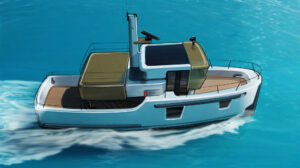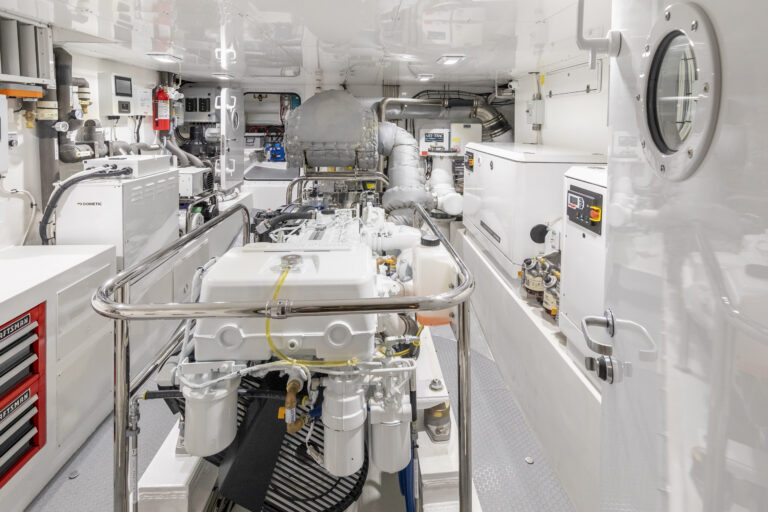By now, you must have heard of 3D Printing. It’s the latest craze in prototyping and the technology has been perfected with various materials, for the production of high quality final parts—the latter being applied to low volume and high complexity parts, like those in the aerospace industry or medical industry.
3D Printing, referred to as additive manufacturing in the industry, is the process of building up a part bit by bit, layer by layer, through the addition of material. Materials can vary greatly from plastics to metals and ceramics and can be delivered in many colors. While the process may sound complicated, companies are simply delivering it and presenting it as just another printer, or a service where the company prints to you and ships the finished part.
This can’t be ready for the average Joe, or can it? I decided to find out. Here are my results.
HOW IT BEGAN
It all started when the sheet metal pan under my stuffing box rotted out. My boat is a custom build, and this pan was an original, likely last minute addition that served reasonably well for more than 25 years. I wanted to keep water out of the bilge, so a redesign was in order.
I had a 2-inch shaft and a nice big stainless steel stuffing box with four bolts for compression. I wanted a tray that would attach to it, but be easy to remove if I need to do any maintenance. I already built a container with a bilge pump in it, and it was sitting down in the bilge, so all I needed was a catch tray to direct water to it via a short hose. I needed to make some kind of drip tray.
Usually, in a case like this, I head down to my nearest West Marine, or Home Depot, and wander the isles for something “close” that I can repurpose for the task, but when I went searching for something that I can repurpose, I wasn’t able to find anything. Having recently read an article on 3D printing, I decided it was worth a try.
BUILDING THE PART
I already had a design in my head, so the first step was to find some software that would allow me to easily turn my vision into reality. I didn’t want to spend hours learning some complicated 3D CAD software. After I researched a little, I discovered there is a wonderful, easy-to-learn (and free) software package for 3D drawing, called SketchUp, available from Google. While primarily developed for architectural drawing, it also works just fine for small parts.
I mastered it in three nights—at least I learned enough to work on my own part. It only took one more night (and I’m only talking an hour or two each night) for me to finish my final part.
When you save a Google SketchUp drawing, it creates an .skp file (short for SketchUp file), but most 3D printers or services need a different format called an .stl file. I checked that detail early on and found a “Plug-In” that you can install with SketchUp that enables the import and export of STL (StereoLithography) files. It was as simple as File – Open – “Stuffing Box Final.skp” and File – Export to STL. Done. My SketchUp drawing looked right, but could it really be this easy?
I searched 3D printing companies on the Internet, which brought up many options. Pricing and delivery varies greatly in this new market. Some providers were clearly targeting high-end prototyping, while others looked more hacker/hobbyist oriented.
I settled on a company called ShapeWays. I created an account on their website. I uploaded my “Stuffing Box Final.stl” file and just a few moments later, I received an email with the printing cost. The quote also appeared in my online account. Parts are quoted by the volume of material they use. Different materials have different costs, of course. My material Strong and Flexible Plastic came in at $1.40 per cm3. Wonderful. It only cost $95 for a plastic part—my custom-designed little work of art. Darn, I forgot to embed my autograph in it. I clicked “Buy” online.

THE FINAL PRODUCT
In five days, UPS delivered a small brown package. “It’s here!” I shouted in the kitchen while my wife rolled her eyes. And there it was: beautiful, solid and exactly what I was hoping for. It was easy. On my next trip to the boat, my work of art was installed. It snapped into place perfectly—no screws needed.

If you are like me, you will get hooked on the idea of 3D printing. Ever hear that saying, “When all you have is a hammer, everything looks like a nail?” Well, these days I look at everything and wonder how I can add to it, or improve it with a 3D printed part. This is new world of design and manufacturing and rather than dealing with a shop full of machines, all you need is imagination and a computer.
Ideas for the future:
- Brackets to mount items
- Unique cup holders
- Special plumbing parts
Shapeways also offers an online store, enabling you to sell your new designs. They handle the order, manufacturing and shipping. You get a monthly commission on your items that have sold. I haven’t listed my tray yet. I don’t think there is much of a market, but if you are interested, let me know.
Another company that is gaining a great deal of attention in the 3D printing space is www.MakerBot.com. They manufacture a low-cost printer for use at home. They have also created a companion site www.Thingiverse.com for sharing 3D drawings. These can be downloaded, imported into SketchUp, or most other design programs, and modified as you see fit. You don’t need to start from scratch. If I can be of any help, feel free to contact me [email protected].
USEFUL RESOURCES:
Sketchup Download – http://www.sketchup.com/download/
SketchUp STL Plugin – http://www.github.com/SketchUp/sketchup-stl
Shapeways – www.shapeways.com
MakerBot – www.MakerBot.com
Thingiverse – www.Thingiverse.com











